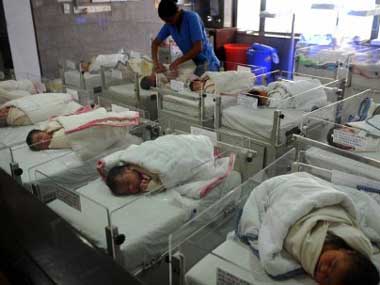By Swagata Yadavar New Delhi: On 11 June, to mark four years of India’s Bharatiya Janata Party-led government, Union health minister JP Nadda
said
: “India has met the MDG (Millenium Development Goal) target for MMR (Maternal Mortality Ratio) of 139/lakh live births by achieving 130 by 2015. At this rate, we shall achieve SDG (Sustainable Development Goal) target of 70 by 2022, ahead of target timeline of 2030.” The World Health Organisation (
WHO
)
commended
India’s MMR decline, calling its performance, “groundbreaking”. But has India achieved its MMR goal? Not according to the MDG target
listed
by the United Nations Development Programme (
UNDP
). This appears to be because the baselines – starting figures – used by the UNDP and the government/WHO to calculate MDGs differ. On 6 June, the government released the latest MMR
data
, as calculated by the Sample Registration Survey (
SRS
), the most regular source for demographic statistics in India. The new data showed that maternal mortality had declined 22 percent over three years, from 167 maternal deaths per 100,000 live births in 2011-13 to 130 deaths per 100,000 live births in 2012-16. [caption id=“attachment_4358925” align=“alignleft” width=“380”] Representational image. AFP[/caption] The millenium development goal for India was to “reduce maternal mortality ratio by three quarters, between 1990 and 2015”. The MMR in 1990 was 437 deaths per 100,000 live births according to the first ever national maternal mortality estimate by
National Family Health Survey
-1 (1992-93). This is cited by ministry of statistics and programme implementation (
MOSPI
) and the
UNDP
. So a 75 percent reduction makes the 2015 MDG target 109. But the MMR in 1990 was 560, according to the
WHO
and the ministry of health and family welfare (
MOHFW
). So a 75 percent reduction leaves the 2015 MDG target at 140. That means India has exceeded the WHO and health ministry target for the MDG but is 21 points behind the UNDP and ministry of statistics MDG target. We sent emails seeking comments to WHO on 12 June, and UNDP, ministry of health and family welfare and MOSPI on 13 June. We will update the story if and when they respond. “Post MDG, Sri Lanka, Brazil and China made significant progress in life expectancy, IMR (Infant Mortality Rate), MMR and adult mortality rate whereas Pakistan and India are lagging behind,” said this 2016 NITI Aayog
report
on Sustainable Development Goals. Should India be happy with its progress on MMR? While India’s MMR is better than some of its neighbours – Pakistan (178), Bangladesh (176) and Nepal (258) – and the global (216) and South Asian average (182), it is much behind Sri Lanka (30) according to
World Bank
figures for 2015. That’s less than a quarter of India’s MMR. India accounts for 17 percent of global
burden
of maternal deaths. The leading
causes
of death in India are haemorrhage (38 percent), sepsis (11 percent) and abortion (8 percent). “An improvement just in MMR figures isn’t enough,” Nitin Bajpai, technical expert at the Population Foundation of India, an advocacy, told FactChecker. “We need to see the cause of maternal death data collected by SRS. We need to see whether there is a reduction in haemorrhage cases, which would mean that the quality of care at health facilities has improved.”
Representational image. AFP[/caption] The millenium development goal for India was to “reduce maternal mortality ratio by three quarters, between 1990 and 2015”. The MMR in 1990 was 437 deaths per 100,000 live births according to the first ever national maternal mortality estimate by
National Family Health Survey
-1 (1992-93). This is cited by ministry of statistics and programme implementation (
MOSPI
) and the
UNDP
. So a 75 percent reduction makes the 2015 MDG target 109. But the MMR in 1990 was 560, according to the
WHO
and the ministry of health and family welfare (
MOHFW
). So a 75 percent reduction leaves the 2015 MDG target at 140. That means India has exceeded the WHO and health ministry target for the MDG but is 21 points behind the UNDP and ministry of statistics MDG target. We sent emails seeking comments to WHO on 12 June, and UNDP, ministry of health and family welfare and MOSPI on 13 June. We will update the story if and when they respond. “Post MDG, Sri Lanka, Brazil and China made significant progress in life expectancy, IMR (Infant Mortality Rate), MMR and adult mortality rate whereas Pakistan and India are lagging behind,” said this 2016 NITI Aayog
report
on Sustainable Development Goals. Should India be happy with its progress on MMR? While India’s MMR is better than some of its neighbours – Pakistan (178), Bangladesh (176) and Nepal (258) – and the global (216) and South Asian average (182), it is much behind Sri Lanka (30) according to
World Bank
figures for 2015. That’s less than a quarter of India’s MMR. India accounts for 17 percent of global
burden
of maternal deaths. The leading
causes
of death in India are haemorrhage (38 percent), sepsis (11 percent) and abortion (8 percent). “An improvement just in MMR figures isn’t enough,” Nitin Bajpai, technical expert at the Population Foundation of India, an advocacy, told FactChecker. “We need to see the cause of maternal death data collected by SRS. We need to see whether there is a reduction in haemorrhage cases, which would mean that the quality of care at health facilities has improved.”
While institutional deliveries have increased from 38.7 percent in 2005-06 to 78.9 percent in 2015-16, the number of women receiving at least four antenatal-care visits – as the WHO recommends – has not risen substantially. Up to 37 percent of women in 2005-06 received four antenatal-care visits, compared to 51.2 percent in 2015-16, according to the National Family Health Survey -4, leaving nearly half of India’s pregnant women with inadequate care, IndiaSpend reported in June 2018. The author is a principal correspondent with IndiaSpend and FactChecker.
)